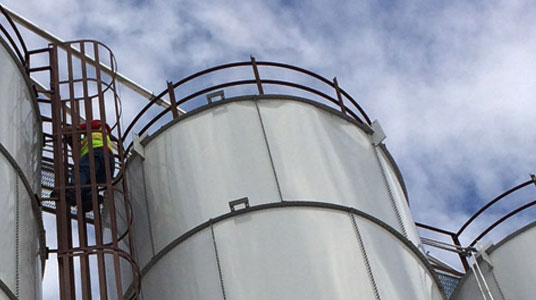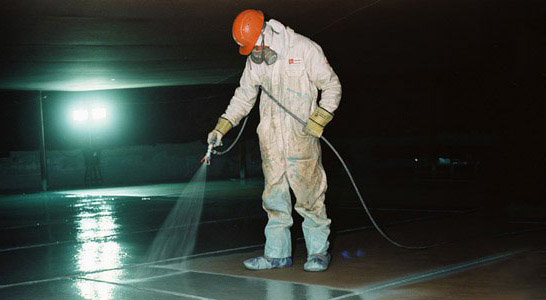Protect Your Water Storage Tanks From Corrosion
If you’re searching for how to “Protect Your Water Storage Tanks From Corrosion“, outdoor water tank coatings, or “Water Tank Rust Treatment” you are probably searching for a company to help protect your water storage tanks. All Kote Lining Inc. helps protect all varieties of storage tanks from corrosion. This article is designed to help you understand the need for this service and also how that service is carried out. If you have any questions please feel free to call 480-966-4446.
Outdoor Water Tank Corrosion Control
Ground level and elevated water storage tanks are the main part of most water distribution systems. Not only will these vessels help to ensure that there is enough hydrostatic pressure as well as plenty of clean drinking water, but have also been landmarks for many places. Although, if they are not maintained properly, they may become a liability because of corrosion caused service interruptions and leaks.
Nowadays, the newer high performance waterborne as well as high solids coating systems are there to help combat corrosion on water storage tanks. Additionally, being able to meet VOC regulations, these eco-friendly coatings have offered applications and finish quality type of advantages over the traditional counterparts. They have formed a strong bond to the steel substrates on the newer tanks have provided better adhesion to already existing coatings on older tanks and will be compatible with protection.
By being able to know about what causes the corrosion and the characteristics of high solids and waterborne coatings, an effective and economical tank maintenance program will be able to made and then carried out.
Destructive Forces on Above Ground Tanks
All water storage tanks are susceptible to a corrosion attack. Selecting the right water tank or cooling tower coating for being able to maintain water storage tanks simply by assessing the corrosive variables that are outside and inside the structure.
Corrosion is a natural thing that has been based on the laws of chemistry, electricity, and metallurgy. The process of refining and smelting steel and iron ore are used in water tanks, then energy is added. This causes an imbalance of energy and nature works to fix this by releasing back the energy as electrons, which cause the metal to rust, or corrode and return as a form of iron oxide.
Corrosion Prevention Coatings
The exterior of the tank and the coatings are accepted as a protection method. The main function of the coating is to make a barrier that prevents moisture and chemical compounds from touching the substrate. Although the electrolyte isn’t always around in this area, ensuring that you are preventing water ingress is vital for protection. Additionally, the coating needs to have good adhesion and abrasion as well as chemical resistant properties and the ability to deal with UV radiation.
Inside of the water tank, the corrosion control approach will be different. A strong electrolyte is formed by stored water that creates a type of vehicle for ion transfers as well as current flow in the steels micro-structure. Although, coatings may be used to interrupt this type of process and help to prevent corrosion. When there is a high dielectric strength, the coating will restrict the electron passage and then prevents metal from having the solution at the anode. If electrons aren’t able to travel to cathode, the corrosion process will be stopped.
New Coating Systems
With the enactment of certain regulations that limit VOC emissions on coatings, there have been a whole new breed of protective coatings that have been made available. The new systems contain urethanes, waterborne epoxies, acrylics, high solid and mastics epoxies. Some of these coatings are better for new tanks, while others are best for existing finishes.
So, are the coatings as good as traditional solvents? Yes. Because most of the coatings are now on the market. New polymers as well as additives that make up the coatings will allow for better application environments as well as improved looks. The main key is to achieve effective control of corrosion by using certain coating systems that have the right properties for the specific tank conditions.
Exterior coatings
Polymers that have been based on acrylic chemistry have managed to prove advantages for application. These have included durability, resistance to UV light, and flexibility. Additionally, comonomers such as acrylonitrile, styrene, and acrylic coatings that have offered superior corrosion and chemical resistance. Additionally, they do possess excellent characteristics for looks because of flow properties of liquid systems without high solvent content. Acrylics can be used as a top coat or primer on the exterior of the tank and can be an attractive alternative to polyurethane and alkyd finishes.
Waterborne epoxies
These epoxies will give the convenience of water based coatings that have performance based qualities of the solvent based system. There is a crosslinking of waterborne polymers that have monomers that have carboxyl or hydroxyl groups, and the coatings will form a dense, tight, film for better corrosion protection and adhesion. They are very acidic, moisture and alkali resistant, and are able to handle abrasion. Waterborne epoxies will dry quickly to stop wash off because old dew or rain. Additionally, adding sodium nitrite will let the epoxies be resistant to flash rusting or early rusting.
High solid epoxy mastics
These offer high degrees of salt, moisture, chemical, and acid resistance which make it a good barrier coating for tanks. This is because they are compatible with intact, old paint films and provide adhesion for marginally, dry prepared substrates that requires very little surface prep. Normally, the coatings will be applied to a prior coated tank as a primer. For those tanks that have lead based alkyd finishes, these coatings give a great base coat that will prevent lifting for a good over-coating of lead particles.
High solid polyurethanes
For a lot of years, lead based alkyds were a very popular coating for the exterior of water tanks. After lead based paints were banned, polyurethane became the choice coating. Now that there are limits for VOC emissions, the high solid polyurethane has become a very widely used coating product. This can be because of their versatility.
Immersion Service Coatings – High Solid Epoxies
There are some coating types that will meet extraction test and toxicological test requirements of the NSF/ANSI standard 61 and long term corrosion protection needs of water tanks. Epoxies and vinyl’s, only the high solid epoxy has been formulated to hit the right limit for VOC emission levels. Because of this, the high solid epoxy has been used for most immersion service applications on storage tanks.
The blistering of the protective coating is a failure of immersion services. When you are lining a blister, the ability to provide corrosion resistance is diminished. If the protection isn’t monitored right, voltage levels can exceed what is needed for polarization. This will cause high levels of hydroxyl ions to form under the paint. This causes the blistering and delamination’s.
Comprehensive Tank Maintenance
Whenever the EPA declared war on pollutants, the water industry feared that the eco-friendly alternative coating systems wouldn’t help with corrosion. This misconception was put to rest with the new high solids and waterborne coating systems. These systems provide protection against corrosion and other benefits. When you examine the properties of the coatings and find the right product for applications, water authorities will be able to create effective and economical tank maintenance programs.
Phoenix Water Tank Maintenance & Coatings
All Kote Lining Inc. offers water tank coatings along with a variety of other chemical storage tank services. We can help with all of your storage tank needs in the Phoenix area with preventative tank maintenance and repair when necessary. We strive to use the best coatings in the business to extend the life of your tanks, save you money, and help preserve the tanks integrity to help protect the environment.



